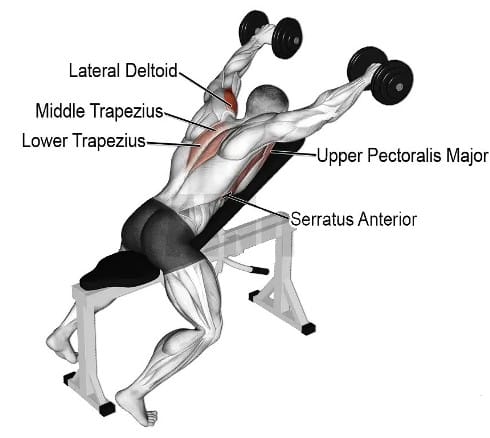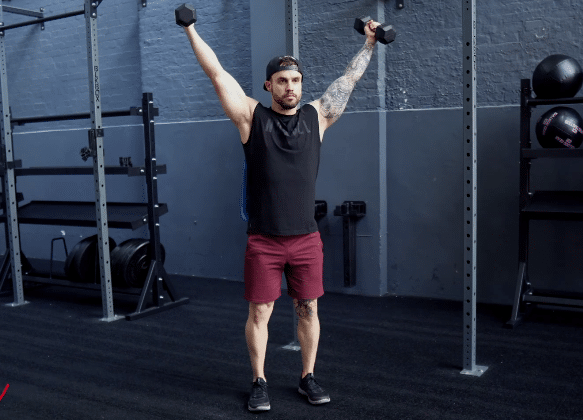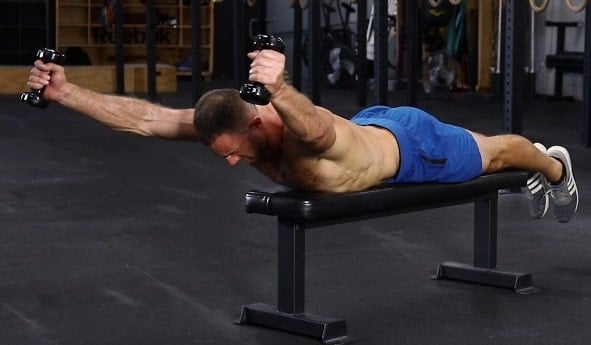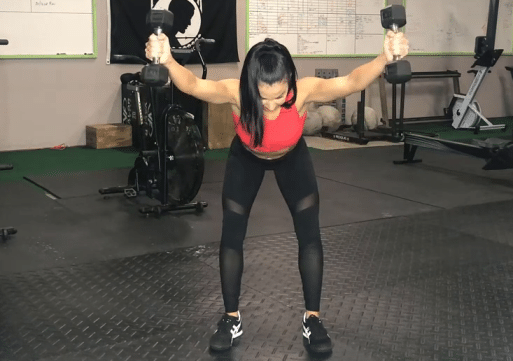Are you looking to enhance your shoulder strength and improve your posture? Look no further than the dumbbell Y raise. It’s an effective addition to your workout routine because it targets key muscles in your shoulders, upper back, and core.
And the best part? Dumbbell Y raises can easily be done at home with just a set of dumbbells.
In this blog post, we’ll delve into the ins and outs of the dumbbell Y raise, from proper form and technique to the numerous benefits it offers.

- What is Dumbbell Y Raise
- Muscles Worked During Dumbbell Y Raise
- 1. Standing Dumbbell Y Raise
- How to Perform the Standing Y Raise
- Tips
- Variations and Modifications Of Dumbbell Y Raise
- 1. Incline Dumbbell Y-Raise
- How To Do Chest Supported Dumbbell Y Raise
- Tips
- 2. Dumbbell Floor Y Raise
- How to Do Dumbbell Floor Y Raise
- Tips
- 3. Bent-Over Dumbbell Y Raise
- How to Do Bent-Over Dumbbell Y Raise
- Tips
- Benefits of the Dumbbell Y raise
- Dumbbell Y Raise Alternative
- 1. T Raise
- 2. W Raise
- 3. L Raise
- Takeaways
- 10 Best Dumbbell Shoulder Exercises For Size & Strength
What is Dumbbell Y Raise
The dumbbell Y raise is a workout that mainly works the muscles in your shoulders and upper back, including rear deltoids, and traps. It gets its name from the shape your arms make during the movement, resembling the letter Y.
To perform a Y raise, you’ll need a pair of dumbbells and ample space to move freely.
The dumbbell Y raise not only targets specific muscle groups, but also improves shoulder stability, posture, and overall upper body strength.
Muscles Worked During Dumbbell Y Raise
- The dumbbell Y raise targets all three heads of the deltoid muscle
- The anterior deltoid (In front)
- Lateral deltoid (at the side)
- Posterior deltoid (behind)
- Other upper back muscles worked during the exercise.
- The dumbbell Y raise indirectly works the rotator cuff muscles and core muscles during the standing raise.

1. Standing Dumbbell Y Raise
The exercise mimics movements used in everyday activities, sports, and athletic performance, making it highly applicable in real-life situations.
The standing Y raise targets the deltoids, trapezius, and rhomboids simultaneously, providing a comprehensive shoulder workout.
The exercise involves lifting dumbbells during standing position in a diagonal motion in order to form a Y shape with your arms.

How to Perform the Standing Y Raise
- Stand with feet shoulder-width apart, holding dumbbells with palms facing inward.
- Lift the dumbbells diagonally out to the sides and upwards, forming a “Y” shape with your arms.
- Keep a slight bend in the elbows and focus on contracting the shoulder muscles.
- Squeeze the shoulder blades together at the top of the movement.
- Lower the dumbbells back to the starting position with control.
Tips
- Start with lighter weights and gradually increase resistance as you progress.
- Maintain proper posture, with a neutral spine and engaged core.
- Focus on the mind-muscle connection and contract the muscles you want to work on.
- Control the speed of the exercise, emphasizing a slow and controlled motion.
Know More: Best Dumbbell Shoulder Exercises For Mass
Variations and Modifications Of Dumbbell Y Raise
By using different angles, equipment, or movements, people can improve their workouts, challenge their muscles, and get better results.
Modifications and variations in workout routines are essential due to the following reasons.
- Offering variety.
- Targeting specific muscle groups.
- Preventing injuries caused by overuse.
- Breaking through plateaus.
- Enhancing functional strength.
- Meeting different needs and goals.
1. Incline Dumbbell Y-Raise
Incline Y dumbbell raises are a great and easy-to-do shoulder stability exercise that targets both the rotator cuff muscles and your mid and lower traps.
Although the Y Raise is commonly performed on an incline bench, it can be modified to suit your needs and performed in a variety of different ways: standing, on the floor, flat or even a Swiss ball.
Some other names for the incline dumbbell Y are:
- Chest supported Y raise.
- Prone dumbbell Y raise.
- Incline Y delt raise

How To Do Chest Supported Dumbbell Y Raise
- Lie face down on a flat bench with your chin past the end of the bench.
- Hold two light dumbbells or weight plates.
- Lift both dumbbells up as high as you can while forming a letter Y with your arms and torso.
- Hold this position for two seconds before returning the dumbbells to the starting position.
- Repeat for the desired number of repetitions.
Tips
- Raise arms up in a slow, controlled manner.
- Be careful not to use too much weight, as it is easy to injure your deltoids.
2. Dumbbell Floor Y Raise
The Dumbbell Floor Y Raise also known as supine Y Raise is a variation of the Y raise exercise performed while lying on the floor.
By eliminating the involvement of the lower body, the focus remains solely on the shoulder and upper back muscles.

How to Do Dumbbell Floor Y Raise
- Lie flat on your stomach on the floor or on a bench with your legs extended
- Hold dumbbells with your arms facing inward.
- Engage your core, press and maintain a neutral spine throughout the movement.
- Lift the dumbbells diagonally out to the sides and upwards, forming a Y shape with your arms.
- At the top of the movement, focus on contracting the shoulder muscles and pulling the shoulder blades together.
- Slowly lower the dumbbells back to the starting position with control.
Tips
- Keep your neck relaxed.
- Avoid swinging the dumbbells or using momentum.
3. Bent-Over Dumbbell Y Raise
The bent-over dumbbell Y raise is an advanced exercise that involves bending forward at the hips while holding dumbbells and performing a Y-shaped.
A significant core engagement is required to maintain stability throughout the bent-over position.

How to Do Bent-Over Dumbbell Y Raise
- Hold dumbbells in each hand and stand with your feet hip-width apart.
- Hinge forward at the hips and keep your back flat and knees bent.
- Let your arms hang down naturally toward the floor, with a little bend at the elbows.
- Lift the dumbbells out to the sides and up in a Y shape with your arms.
- Squeeze your shoulder blades together at the top of the movement.
- Slowly lower the dumbbells back to the starting position with control.
Tips
- Maintain a strong and stable core by engaging your abdominal muscles.
- Avoiding back arching or rounding too much.
- Always breathe out when you lift and inhale when you lower it.
Benefits of the Dumbbell Y raise
- Targets multiple shoulder muscles, including the deltoids, trapezius, and rhomboids.
- Improves shoulder stability and reduces the risk of injuries.
- This exercise is great for those looking to build shoulder strength and improve posture
- Enhances the ability to do daily activities and sports activities.
- The task requires minimal equipment and can be performed in a variety of ways.
- It improves strength, endurance, and aesthetics in the shoulder area.
- This exercise option is suitable for individuals of different fitness levels and goals.
Know More: 21 Bodyweight Shoulder Exercises: Beginner to Advance
Dumbbell Y Raise Alternative
Here are some alternatives to the Y raise exercise for those who want to change up their shoulder workout:
1. T Raise
You can make a “T” shape with your body by raising your arms out in front of you instead of raising them out to the sides.
2. W Raise
Instead of extending your arms out to the sides, raise them at a 45-degree angle to form a “W” shape with your body.
3. L Raise
To create an L-shaped shape with your body, instead of doing Y raise.
Takeaways
Y raise is a time-efficient shoulder exercise that’s also good for your posture and joint health. It would be a good addition to your workout library.
It is important to mix up your shoulder workout routine with other shoulder exercises for overall shoulder development.
10 Best Dumbbell Shoulder Exercises For Size & Strength

Manish brings over 10 years of hands-on experience in weight lifting and fat loss to fitness coaching. He specializes in gym-based training and has a lot of knowledge about exercise, lifting technique, biomechanics, and more.
Through “Fit Life Regime,” he generously shares the insights he’s gained over a decade in the field. His goal is to equip others with the knowledge to start their own fitness journey.
